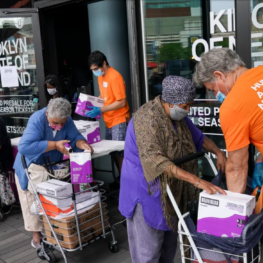
Elderly people collect fresh produce and shelf-stable pantry items outside Barclays Center as Food Bank For New York City provides assistance to those in need on Thursday, Sept. 10, 2020, in New York.
Between 2021 and 2022, the number of New Yorkers living in poverty grew from 1.5 million to 2 million, with nearly 500,000 more people in New York living in poverty than the year prior. The overall poverty rate increased from 18% to 23%.
A full 25% of children in New York City — nearly 420,000 children — lived in poverty in 2022, the highest rate since 2015.
A January 2024 state Health Department report revealed that “approximately one in four adults (24.9%) in New York State experience food insecurity,” with the highest rates of food insecurity across the state falling in three New York City counties: Bronx, Queens, and Kings.
These are but three examples of a disturbing fact: New Yorkers need our help now more than ever.
Through our robust social service networks, Met Council on Jewish Poverty, Catholic Charities and Hispanic Federation, have seen this play out firsthand.
For context, we are not new to navigating needs in times of crisis. Met Council on Jewish Poverty, Catholic Charities and Hispanic Federation have long been leaders in providing services in difficult times. In the last 20-plus years alone, we have helped New Yorkers navigate 9/11, the Great Recession, Hurricane Sandy and the pandemic, and our organizations have remained at the forefront, responding to the needs of our neighbors.
With our dedicated staff and volunteers, we have demonstrated a proven record of providing culturally relevant, high quality services from affordable housing to crisis intervention, family violence support, benefits enrollment, vocational counseling, and so much more.
And, with a collective 200-plus years of service and more than one million New Yorkers assisted every year, we are seeing something unlike ever before: record numbers of people reaching out to us to help with their most basic needs, most notably food. As New Yorkers, we know our neighborhoods, we know our communities and we know we are the best ones to serve their needs.
People suffering food insecurity are people that look like any one of us. They are hardworking families — school teachers and nurses — who report not being able to afford basic necessities, seniors on a fixed income falling behind as rents continue to soar, and everyday New Yorkers struggling to pay their bills.
In each of these examples are everyday people who are grappling with rising food costs, and who are being forced to make the difficult decisions of not eating or paying for fixed costs like rent.
Thankfully, our past experience gives us a solution.
During the pandemic, at the height of need and significant uncertainty, New York City wisely created a special fund for emergency food — allowing for an injection of additional resources that allowed for targeted support to go to hard to reach, historically underserved communities.
This funding allowed us to deploy needed resources to areas with limited pantry and social service infrastructure, to communities with religiously informed or culturally nuanced diets which have often been left out of the traditional emergency food system, and to programs that facilitated increased access through the use of innovative models that lead to an efficient and productive emergency food system.
Through this effort, communities in every City Council district and indeed every community benefited. This funding had an immediate impact. It leveled the playing field, reduced barriers to access for New Yorkers, and created an important and direct infusion of needed food and funding to support those doing the critical work of supporting New Yorkers in need. But most importantly: it fed New Yorkers in need.
Our organizations — and hundreds of others as well — saw firsthand the value of this funding. And our clients — representing all of the great diversity of this city — spoke about the benefits of not having to travel to a food pantry, the benefits of having foods that meet their families’ needs and the benefits of feeling seen and supported by others. This funding not only became a lifeline, it augmented service delivery in ways that will forever shape how the emergency food system operates.
In partnership with community based organizations and local partners, we know how to deliver for hungry New Yorkers. Now, we need the government to do its part. With a budget deal looming, we implore the City Council and mayor to allocate an additional $20 million to ensure that people get the food they need.
No one in New York City should have to worry about where their next meal comes from. That’s why we need money for food.
Greenfield is the CEO of the Met Council on Jewish Poverty. Rosenberg is executive director of the Catholic Community Relations Council of New York. Miranda is the president and CEO of the Hispanic Federation.
